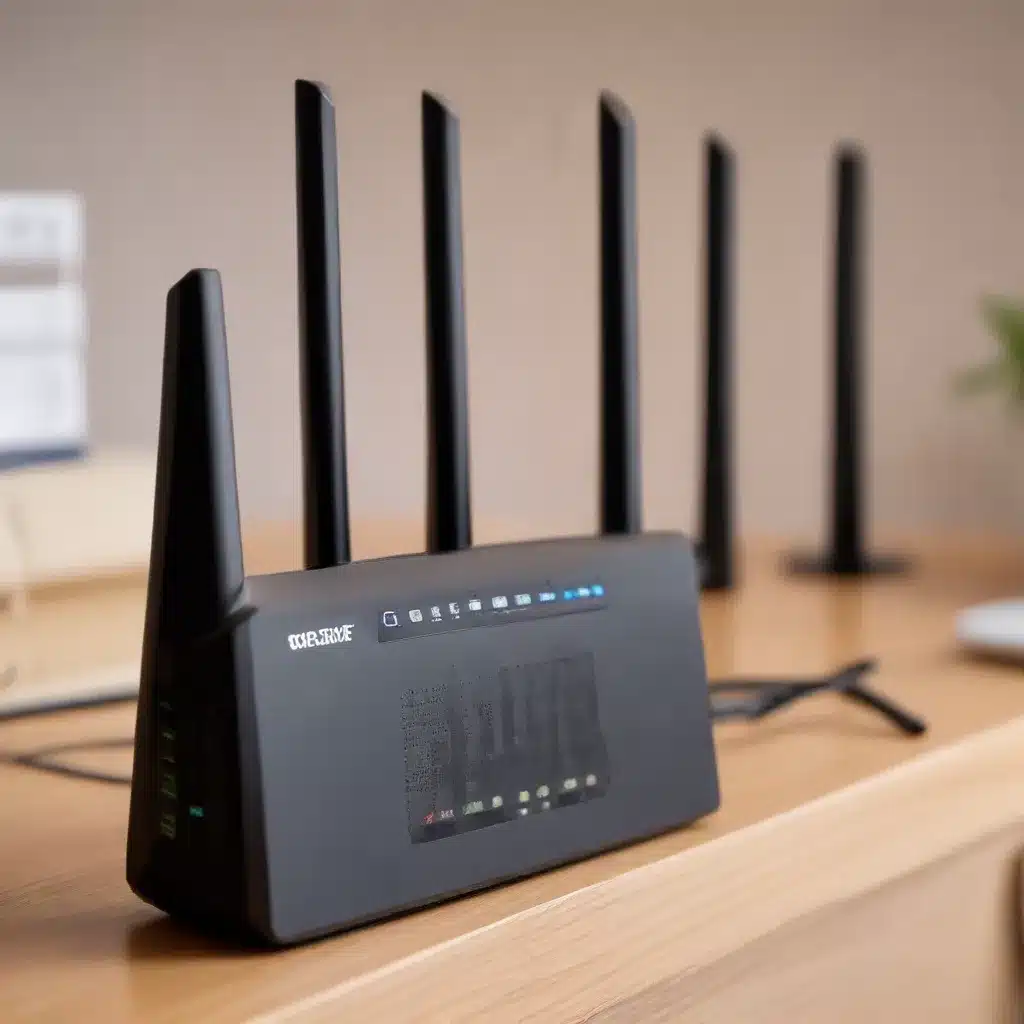
As an experienced IT specialist, I’ve seen firsthand how crucial it is to have a secure home network setup. Over the years, I’ve encountered countless issues stemming from poorly configured routers, leaving homeowners vulnerable to cyber threats. However, with the right precautions and a little technical know-how, you can dramatically improve the security of your home network and protect your devices and personal information.
Securing Your Router: Strategies for Success
One of the primary entry points for cyber attackers is the humble home router. These unassuming devices act as the gatekeepers to your network, and if they’re not properly secured, they can leave your entire home system exposed. As an IT specialist, I always emphasize the importance of securing your router’s settings to create a strong first line of defense.
Prioritizing Router Security Settings
When it comes to router security, the first and most critical step is to ensure that your router’s security settings are optimized. This means choosing the right encryption protocol, setting a strong password, and keeping your firmware up to date. An official government website recommends using the latest and most secure protocol, WPA3 Personal, or the transitional WPA2/WPA3 mode for better compatibility with older devices.
But the security measures don’t stop there. It’s also essential to set a unique and robust password for your network, avoiding common default names or easily guessed phrases. This simple step can go a long way in deterring would-be intruders from accessing your network.
Navigating Dual-Band Connectivity
Another important consideration for home network security is the use of dual-band routers. These devices offer both 2.4GHz and 5GHz wireless frequencies, each with its own advantages and challenges. As I’ve learned from experience, connecting your devices to the appropriate band can make a significant difference in your network’s stability and security.
For instance, I’ve encountered several instances where users struggled to connect their smart home devices, such as security cameras or IoT gadgets, to their home networks. Often, the culprit was the router’s settings, with the 5GHz band causing compatibility issues for these lower-powered devices. As this forum post suggests, the solution was to temporarily disable the 5GHz band and connect the devices to the 2.4GHz network, which they’re better equipped to handle.
Leveraging Firmware Updates
Keeping your router’s firmware up to date is another crucial step in maintaining a secure home network. Manufacturers regularly release software updates that address known security vulnerabilities, patch bugs, and improve overall performance. As an IT specialist, I can’t stress enough the importance of enabling automatic firmware updates on your router.
Many users make the mistake of neglecting these updates, assuming their routers are functioning well enough as is. However, this can leave them vulnerable to the latest cyber threats, as attackers are constantly developing new ways to infiltrate unprotected networks. The CISA website emphasizes the need for these defense-in-depth practices to minimize the risk of successful attacks.
Optimizing Network Performance and Reliability
While security is undoubtedly the primary concern when it comes to home network setup, it’s also essential to consider performance and reliability factors. After all, what good is a secure network if it’s plagued by connectivity issues or sluggish speeds?
Choosing the Right Wireless Bands
As I mentioned earlier, the choice between 2.4GHz and 5GHz wireless bands can have a significant impact on your network’s performance. The 5GHz band generally offers faster data speeds and less interference, making it the preferred option for devices like laptops, smartphones, and streaming media players.
However, the 2.4GHz band has better range and penetration, making it a better fit for devices that need a more reliable connection, such as smart home accessories or older gadgets. By understanding the strengths and weaknesses of each band, you can optimize your network setup to ensure the best possible experience for all your connected devices.
Optimizing Channel Width and Settings
Another important consideration for network performance is the channel width and channel selection settings on your router. The channel width, measured in megahertz (MHz), determines the size of the “pipe” through which your data flows. Wider channels, such as 40MHz or 80MHz, can provide faster speeds, but they’re also more susceptible to interference from nearby networks.
According to Apple’s support documentation, the recommended settings are 20MHz for the 2.4GHz band and Auto or all widths for the 5GHz and 6GHz bands. This helps to balance performance and reliability, especially in crowded urban environments where multiple networks may be competing for the same airspace.
When it comes to channel selection, it’s best to let your router handle this automatically, as it can dynamically adjust to the least congested channel based on the wireless interference in your local environment. Manually selecting a channel can be a trial-and-error process, and it may not always yield the best results.
Ensuring Consistent SSID and Password
One often-overlooked aspect of home network setup is the consistency of your SSID (network name) and password across all bands and devices. As an IT specialist, I’ve encountered numerous situations where users struggled to connect their devices, only to find that the network settings were inconsistent or confusing.
To avoid these headaches, it’s crucial to use the same SSID and password for all wireless bands on your router. This ensures that your devices can seamlessly connect to the network without having to remember multiple login credentials or search for the right band. The Apple support article further emphasizes the importance of using a unique, case-sensitive SSID to prevent your devices from accidentally connecting to nearby networks with the same name.
Protecting Your Smart Home Devices
In today’s increasingly connected world, the proliferation of smart home devices has introduced a new set of security challenges for homeowners. These internet-enabled devices, from security cameras to smart lightbulbs, can serve as entry points for cyber criminals if they’re not properly secured.
Addressing IoT Device Vulnerabilities
One of the common issues I’ve encountered with smart home devices is their reliance on older, less secure wireless protocols. Many IoT gadgets, such as old-generation security cameras or smart plugs, may only support 2.4GHz connectivity and use outdated encryption methods like WEP or WPA.
This can be problematic, as these legacy protocols are no longer considered secure and can leave your network exposed. To mitigate this risk, it’s essential to ensure that your router is configured to use the latest and most secure wireless standards, such as WPA3 Personal or WPA2/WPA3 Transitional, as recommended by government cybersecurity agencies.
Additionally, regularly updating the firmware on your smart home devices can help patch known vulnerabilities and improve their overall security posture. Unfortunately, some manufacturers are better than others when it comes to providing timely firmware updates, so it’s important to stay vigilant and proactively monitor for any security advisories or recalls related to your connected devices.
Separating Guest Networks
Another effective strategy for protecting your smart home devices is to create a separate guest network for your visitors and temporary users. By isolating your personal devices and IoT gadgets from the guest network, you can significantly reduce the risk of unauthorized access or data leaks.
Many modern routers offer built-in guest network functionality, allowing you to configure a separate SSID and password for your guests. This not only keeps your primary network secure but also prevents your visitors from inadvertently accessing or tampering with your smart home devices.
Embracing the Future of Home Networking
As technology continues to evolve at a breakneck pace, the landscape of home networking is also undergoing a dramatic transformation. From the advent of Wi-Fi 6 to the growing prevalence of mesh networking systems, the future of home connectivity is both exciting and challenging.
Navigating the Transition to Wi-Fi 6
One of the most significant advancements in the home networking realm is the introduction of Wi-Fi 6, also known as 802.11ax. This new wireless standard promises faster speeds, improved capacity, and enhanced power efficiency, making it an attractive option for homeowners looking to future-proof their networks.
However, the transition to Wi-Fi 6 is not without its challenges. As an IT specialist, I’ve encountered situations where users struggled to connect their older devices to Wi-Fi 6-enabled routers, leading to compatibility issues and frustration. To ensure a smooth migration, it’s crucial to carefully consider the Wi-Fi capabilities of all your devices and to configure your router’s settings accordingly.
Exploring the Benefits of Mesh Networking
Another emerging trend in the home networking space is the rise of mesh systems, which offer a more comprehensive and flexible approach to wireless coverage. Unlike traditional routers that rely on a single access point, mesh networks utilize multiple nodes strategically placed throughout the home to provide seamless, whole-house connectivity.
One of the key advantages of mesh networking, from an IT specialist’s perspective, is the improved reliability and performance it can offer. By dynamically routing traffic between the various nodes, mesh systems can adapt to changing conditions and ensure that your devices always have a strong, uninterrupted connection.
Additionally, mesh networks often incorporate advanced features like automatic firmware updates and centralized management, making them a more user-friendly and secure option for homeowners who may not have the technical expertise to manage a traditional router setup.
Empowering Users for a Secure and Reliable Home Network
As an experienced IT specialist, my goal is to empower homeowners with the knowledge and tools they need to create a secure and reliable home network. By understanding the critical security settings, optimizing performance, and embracing the latest networking technologies, you can enjoy the benefits of a well-protected and high-performing home connectivity solution.
Remember, the security of your home network is not just about protecting your devices – it’s about safeguarding your personal information, your digital assets, and your family’s online activities. By taking the time to properly configure your router and maintain your network, you’re not only making it harder for cyber threats to gain a foothold but also ensuring a seamless and enjoyable digital experience for everyone in your home.
So, what are you waiting for? Dive into your router’s settings, explore the latest networking trends, and take control of your home’s digital future. With the right approach and a little tech-savvy, you can create a home network that is both secure and optimized for maximum performance. Visit our website to learn more about our IT support services and how we can help you achieve your home networking goals.












